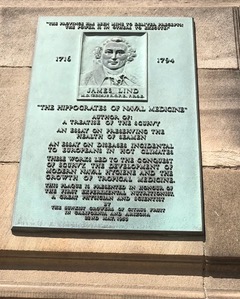A look at the history of some of the prominent buildings of Edinburgh University with Blue Badge guide Kristine Sander
As Post Graduate participants in the first group studying for an MBA (Master of Business Administration) at Edinburgh University 40 years ago we were kept busy. I am determined to catch up on this area and its buildings.
It all started with the Toun Council pledging financial support for a place for learning in 1583.
Greyfriars Churchyard with connections to Harry Potter novels and Bobby’s dog sculpture are left behind heading into Forrest Road, still busy with student clientele in cafés and pubs and now joined by many visitors. One of the pubs is the original Forrest Hill Bar, now named officially Sandy Bell’s as it was known amongst us when Sandy served us, the welcoming landlord who allowed the place to develop into a world renowned folk bar. Way back in the late seventies, home sick Orcadians and Shetlanders met there to listen to and play folk, mixing with famous locals like Hamish Henderson. As an academic he was collecting folk songs for the Archive at the Edinburgh University School of Scottish Studies.

Occupying the opposite corner of Forrest Road is a church used as a Festival Fringe venue since 1977. In term time it stages performances organised by the Edinburgh University Theatre Company. Known as Bedlam Theatre, the name is a reminder that a lunatic asylum stood in the neighbourhood as part of the poor house in former times. Apparently St Mary’s of Bethlehem was the name of a mental hospital in London, Bedlam being the abbreviation.
Round the corner from the Sandy Bell’s is a wee lane called Forrest Hill. It leads up to the imposing entrance of Nr 5, an Edinburgh University building of character. The old poor house was converted in 1859, parts of it incorporated into fabric of the Drill Hall, a space for the newly founded university branch of the Queen’s Edinburgh Rifle Volunteers Brigade (QERVB) under command of the Royal Scots Regiment. The idea of voluntary citizen brigades was carried on into the 20th century, changing its name eventually to the Territorial Army. The Drill Hall entrance saw a rebuild in 1904. It was inaugurated a year later by the Duke of Connaught, Queen Victoria’s third son. In his role as General of the Admiralty he tried to correct the systemic cruelty meted out on the lower ranks of the Army and Navy.
When the Traverse and the Theatre of Scotland were looking for a venue for a play with music on a similar topic the Drill Hall served this purpose. The playwright Gregory Burke had written Black Watch, which was performed there during the Fringe in 2006. In the following years it toured the world winning 22 awards, being deemed one of the best Scottish plays ever. Personally I agree, being on first night in the audience with Sean Connery, Magnus Linklater of the Scotsman and many Scottish actors still performing today. The play ended in awestruck silence until breaking into thunderous applause for the most moving performance in Scots.
On the way towards the Medical School we pass the Corner pub ‘Doctors,’ close to its Renaissance style façade along one side of Teviot Place. McEwan Hall forms the end at the far side.

In the centre the sheltered entrance greets the visitor with an array of memorial plaques of famous doctors, surgeons and teachers associated with Edinburgh University medical school. Amongst them are Lord Lister of “anti germ” fame and Arthur Conan Doyle, author of the Sherlock Holmes stories. Conan Doyle worked as a clerk for Professor Joseph Bell and admired his observant ways. Later he embellished the character of the detective with this skill.

The Elsie Inglis Quadrangle is framed on four sides by university teaching facilities, shared with other subjects these days. A memorial plaque to James Lind is pinned on the wall, explaining his achievements finding a cure for scurvy and research into tropical diseases. He was employed by the Admiralty.
Crossing the quadrangle towards the the South side we reach the Anatomy Lecture hall, important because of rising demand for trained doctors and surgeons accompanying ships sailing into far flung parts of the British Empire. Bodies ready for dissecting demonstrations were brought to the Anatomy Lecture along a corridor connecting to a back entrance out of view of the public.
Using this path I continue to the main entrance of the ceremonial hall named after the Liberal MP for Edinburgh in 1886. William McEwan, a wealthy beer brewer, donated a large sum to the site acquisition and rising building costs. McEwan Hall is used for graduation ceremonies and other official functions. Its startling interior increased the building costs. Outside an elaborate stone carving above the main entrance pays homage to successful graduates receiving their degrees.
Opposite McEwan Hall stands the Concert Hall named after its donor, John Reid, a high ranking army officer and musician. A grateful alumnus in the 19th century he then embarked on a sixty year military career during which he dedicated time composing and playing the flute. His slow march composition is still played by the bands of the Regiment of Scotland. His donation to the University was to be employed to construct the hall. Every year a concert is given there to commemorate John Reid’s birthday on the 13 February.
Next to the Concert Hall we get a good view of the Teviot House Student Union, conceived in 1886 while recognising the need for a Student Union to offer amenities fostering wellbeing and recreation amongst the young. It was to be run by students for students, a novel idea of democracy.
The library, formerly designated to quiet pursuits, retains its name until today but has mutated into a bar!



Leave a Reply